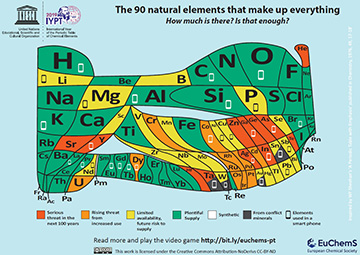An updated periodic table compiled by the European Chemical Society (EuChemS) highlights important chemical elements that could experience future supply shortages. [Image: European Chemical Society, CC-BY-ND] [Enlarge image]
The United Nations Educational, Scientific and Cultural Organization (UNESCO) has named 2019 the Year of the Periodic Table of Chemical Elements, in recognition of the 150th anniversary of Dmitri Mendeleev’s original publication of the table in 1869. In the century and a half since then, the demands wrought by industrial and technological society have put the supplies of many of the 90 naturally occurring elements under stress.
To emphasize the potential scarcity of several key elements—particularly those found in short-life-span consumer devices such as smartphones—the European Chemical Society (EuChemS) has assembled a new version of the periodic table that highlights specific substances under threat. And a number of items prominent on this “endangered-species list” of chemical elements are important materials for electronics and integrated photonics.
From green to red
The new periodic table, which updates a version published in 2015 on the website Compound Interest, lays out the 90 naturally occurring elements from hydrogen to uranium in a color-coded chart. Each element is allotted an area tied to the logarithm of the estimated number of atoms of the element that exist in nature.
Elements color-coded red are those said to be under “serious threat in the next 100 years,” while those in green are deemed to be in plentiful supply. Materials color-coded orange are those for which the likelihood of increased future use could put supplies in jeopardy, and yellow-colored elements are those for which current availability is limited, again potentially putting future supplies at risk.
The chart also calls out elements derived from “conflict minerals”—ores largely mined in countries involved in wars or conflicts over mineral rights, with more limited supplies found in non-conflict countries. And a cellphone icon stamped on selected elements emphasizes their importance in smartphones and other mobile devices.
Induim supplies in danger
A number of the elements on the endangered list amount to the equivalent of household names in photonics and optoelectronics. The supporting notes prepared by EuChemS to accompany the table particularly call out indium—found in the indium-tin-oxide conducting films used in smartphone touchscreens, and in the indium phosphide semiconductors increasingly important in integrated photonics. (Interestingly, phosphorous shows up on the chart as a “yellow” element, for which supplies are already under stress.)
“At current usage rates,” according to the EuChemS notes, “indium will be used up in 50 years and will become very expensive to collect and purify.” In light of that, the organization stresses, there needs to be a greater emphasis on efficient recycling of indium, and on the development of “alternative transparent conducting coatings using earth abundant elements.”
Also on the red list are a number of other elements important for semiconductor technology, including gallium, arsenic and germanium, as well as rare earths and metals such as yttrium, zinc and silver. EuChemS also emphasizes the potential stress on future supplies of lithium, particularly as demand for lithium-ion batteries in electric vehicles becomes more widespread, underscoring the need for a better recycling effort. And, as has been widely reported, shortages in supplies of helium—a material with a wide array of scientific uses—have become an increasing concern.
Smartphones and the “circular economy”
One particular emphasis of the EuChemS periodic table is the importance to consumer smartphone technology of various chemical elements—including many that are increasingly under threat. Some 31 of the 90 elements on the table include the smartphone icon, indicating that they’re used in mobile technology—and of those 31 elements, the supply of 17 “may give cause for concern in years to come,” according to EuChemS. Moreover, all four of the elements on the table derived from conflict minerals—tantalum, tungsten, gold and tin—are important in smartphone manufacture.
The clear message, according to the table’s compilers, is a need to beef up sustainability efforts and the drive toward a “circular economy” that emphasizes maximum recovery and reuse of materials. “It’s … deeply worrying to see how many elements are on the endangered list, including those which make up mobile phones,” Catherine Stihler, the Labour member of the European Parliament (MEP) for Scotland and a former rector of the University of St. Andrews, U.K., said in a press release. “It is a lesson to us all to care for the world around us, as these naturally occurring elements won’t last forever unless we increase global recycling rates and governments introduce a genuine circular economy.”
Stihler, along with fellow British MEP Clare Moody, will help launch the updated periodic table at an event on 22 January at the European Parliament in Brussels.

